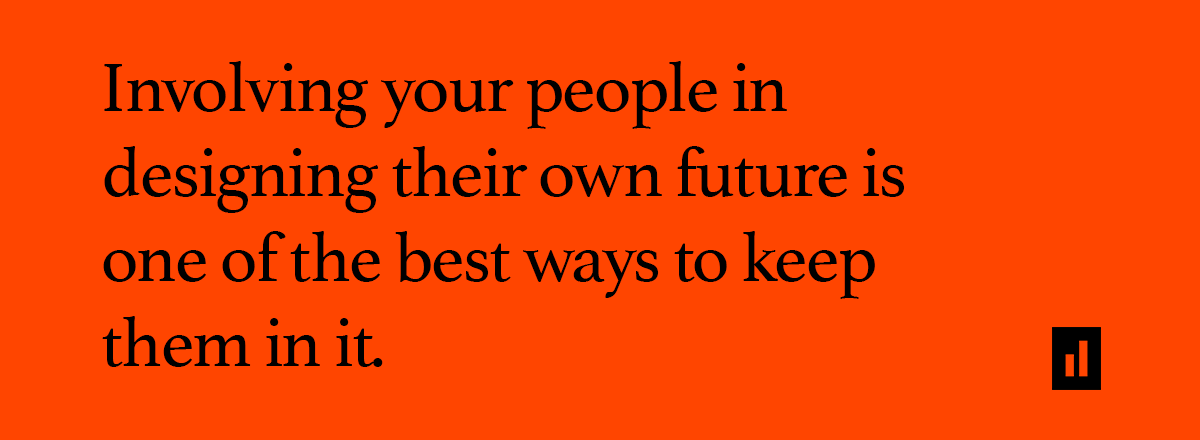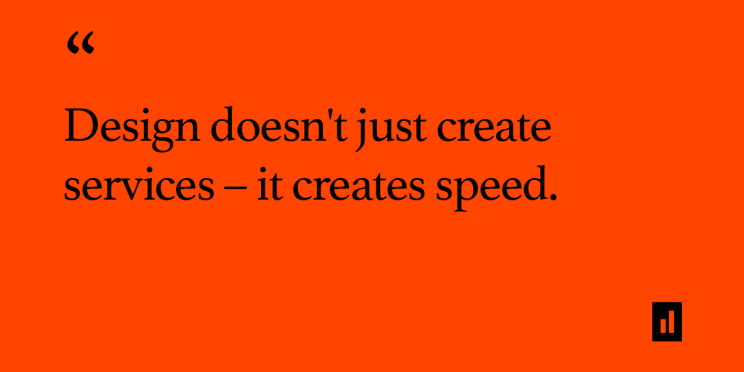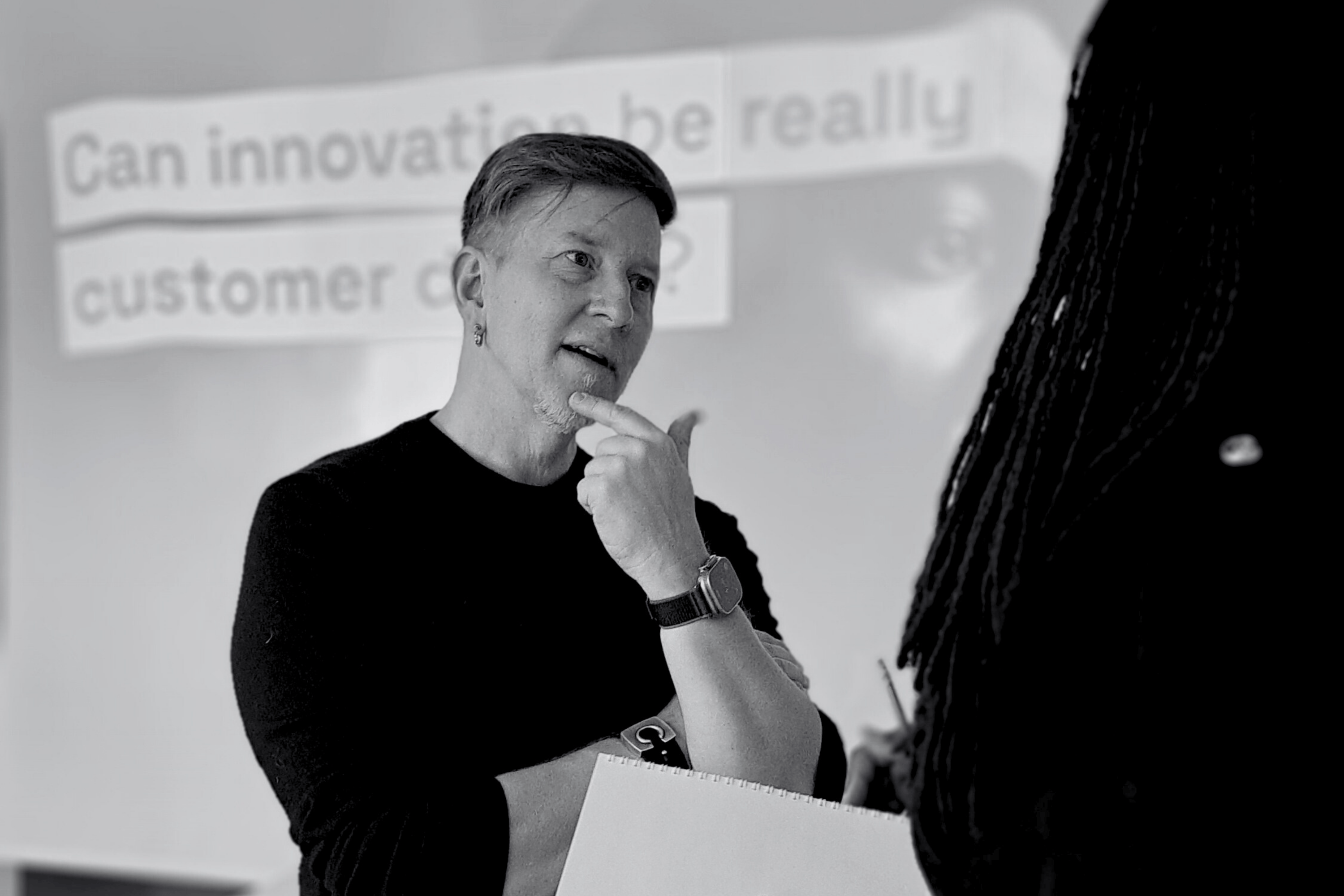
Friction: Where momentum gets stuck
Welcome to part 2/7 of the Change Acceleration series!
This article examines how everyday inefficiencies — slow starts, messy handovers, redundant approvals — create organizational friction that slows change initiatives. Through design methods, teams can reduce friction not by diagnosing it, but by showing what smoother motion looks like. Part of our foundational exploration of Change Acceleration, Friction represents the first of four interconnected barriers to organizational momentum.
The Invisible Cost in Every Project
Every organization has big plans. Bold strategies, innovation programs, transformation roadmaps. But somewhere between the kickoff and the outcomes, progress slows. Decisions drag. Energy drops. Meetings multiply.
That slow bleed is friction.
In a European economic landscape marked by uncertainty – with the war in Ukraine, political polarization, and rising pressure on margins – many organizations are being asked to do more with less. Faster returns, leaner teams, fewer buffers for error.
As a result, strategies are getting more desperate, and more disconnected. A cost-saving initiative launched in one corner of the company gets blocked by approval loops in another. New digital services launch disconnected from other initiatives. Employees ask the quiet question out loud: “Why were we doing this again?”
This is where friction becomes fatal. Not because the ideas are bad, but because the way they land creates resistance, confusion, or apathy.
As Stanford’s Bob Sutton puts it: “Friction is anything that makes it harder to do good work.”
"Friction is anything that makes it harder to do good work"
McKinsey’s work on transformation echoes the same: while some friction can be useful (forcing reflection, protecting against hasty action), too much of it becomes organizational drag, and that drag is expensive.
Harvard Business Review estimates that excessive internal friction – in the form of management structures resulting in wasted time, redundant communication, and process overhead – may cost the U.S. economy over $3 trillion a year.
That’s not friction as metaphor. That’s friction as the bottom line.
How Friction Shows Up
Friction rarely announces itself directly. Instead, it shows up in subtle, familiar ways, as patterns that feel normal but quietly slow things down. Across teams and organizations, a few signals tend to repeat:
⛔️ Slow project starts
New initiatives get the go-ahead, but go on pause for vendor selection and internal brainstorming. People wait for input, clarification, or capacity that never quite materializes. The work might be fully approved, but the kickoff drags. You might hear someone wonder why “it takes longer to start a project than to finish it.”
☑ Redundant approvals
Even small changes require multiple rounds of sign-off. This leadership problem becomes apparent due to the need for control. Different levels of leadership want visibility before anything moves forward, even when decisions have already been aligned. It’s not unusual to hear people question why “so many people need to say yes before anyone can act.”
😵 Confusion over ownership or accountability
When no one’s quite sure who’s responsible, progress stalls. A project or pilot might be valuable and supported, but unclear handovers or overlapping roles mean no one feels confident taking the next step. KPIs set somewhere in the organization might cause an across silos initiative to get stuck in limbo. In these moments, you can hear a sentiment like, “This is not really on my desk, although I’m the one pushing it forwards”.
༗ “We’ve always done it this way” logic
Sometimes, the slowdown isn’t structural but cultural. Familiar routines feel safe. New approaches bring risk. Even when people agree something could be improved, there’s hesitation to deviate from the norm.
New AI tools often land in this zone of uncertainty: full of potential, but greeted with hesitation or unclear policy. Teams aren’t sure what’s allowed, or how to integrate them without risk. This reinforces old routines instead of breaking them — even when the tools could reduce friction themselves.
This can be amplified by unclear governance. In the absence of a shared model for how change is introduced or approved, people revert to old patterns — not because they’re best, but because they feel safest. This points to a deeper issue we’ll explore in the next article: the disconnects between roles, decisions, and expectations that quietly block momentum.
Why Friction Slows Change
Change doesn’t fail at the level of vision. It fails in the daily experience of trying to get things done.
And when small delays stack up, they don’t just cost time, but they cost belief. People stop raising ideas. Stop trusting timelines and stop trying. Over time, this contributes to attrition. For change to accelerate, friction should be actively addressed and not just tolerated.
However, addressing friction intentionally is typically a disconnected initiative by itself. As an across-company item, it should touch on ways of working, governance, methodologies and responsibilities, which are areas we’ll come back to under the lens of Disconnects.
In terms of time and effort, projects in that realm can be hostile to the pressure of the current economy. Especially when the output becomes abstract guidance — slide decks with titles like ‘Recognize weak signals early,’ but no link to how real work will change. Instead of reducing friction, they quietly add to it.
In many organizations, especially those driven by billable work, this creates a deeper tension. Initiatives to reduce friction are deprioritized because they don’t show immediate revenue. Billable tasks win by default, even when they’re slowed down by the very inefficiencies we’re trying to remove. The result is a mismatch between strategy and reality: everyone agrees things should move faster, but no one has time to fix what’s slowing them down.
Some tools, like AI copilots or workflow optimizers, offer real promise in reducing friction — but without the time or support to explore them, teams often default to the old way of working. Friction wins by inertia.
This is why traditional friction-reduction efforts like audits, new playbooks, or org-wide transformation programs, often stall. They require headroom that doesn’t exist.
So instead of treating friction as a separate initiative, we treat it as an opportunity within the work already happening. We design ways to make that work flow better; with less resistance, clearer direction, and faster iteration; without pulling people off billable priorities. In other words, we don’t ask teams to pause to reduce friction. We reduce it while moving.

Change Alongside Existing Initiatives
There’s actually no shortage of frameworks to identify and remove organizational friction. But in our work, we’ve found something simpler, and faster, works better:
We reduce friction by showing what better looks like.
Instead of writing slide decks about how to fix broken handoffs, we design and implement a new one alongside an existing project. Instead of diagnosing blockers in a tool, we prototype a better workflow and test it with real people. Instead of explaining how things should move faster, we move first and display it.
Prototypes, blueprints, process maps and mockups are understood the same way by the C-level, the manager, and the factory floor. Everyone sees the same thing, and everyone gets the point, which is not the case with traditional reports.
Lengthy documentation often reflects how one person understood the problem, and not how everyone will act on it. What’s worse, the language used can easily become too technical, abstract, or simply misaligned with how the rest of the organization talks. It alienates the reader instead of aligning them.
So, building visual items instead of documentation affects friction. Simple, yes. But not yet effective enough by itself.
We need to build these items with the people affected, and not for them. That early involvement creates ownership, and flattens resistance. As key talent retention is paramount to reduce friction, involving your people in designing their own future is one of the best ways to keep them in it.
The result:
- Faster validation of what works
- Clearer ownership of what needs to change
- Less overhead in convincing others to act
- More speed and shorter time-to-market for any new service, structure, or process
Because when friction goes down, acceleration kicks in. In short: the organization starts to regain its forward motion.
Change In Positioning

For us as designers, this can represent a major shift in positioning. It’s why we’ve moved from focusing on surfaces to working on the system beneath (as outlined in the primer article). It’s a way to accelerate change by removing friction through clarity, speed, and inclusion.
Mapping what exists. Prototyping what could work. Visualizing the system so everyone understands it the same way. Including the people affected by the change in shaping the solution. These are not just creative exercises – they’re friction-reducing tools.
And more often than not, these tools offer a faster and more grounded path to real change than heavy documentation or long diagnostic phases. Not by skipping complexity but by showing what better could look like.
The challenge lies in how we talk about this kind of design. Many ask how to write a brief that enables work across silos and reaches vertically through leadership layers. A good starting point is to shift the conversation away from obvious outputs – like services or touchpoints – and toward processes or functions that already cut across the organization, such as legal, customer service, or sales.
Designers have known this potential ever since the early days of human-centered design and service design. But somewhere along the way, the guidance and sales of design have misdirected the focus, leading to misplaced effort. The result: designers bound to narrow targets and constrained roles.
What talented external designers need is to stop designing the self-evident touchpoints and redirect that same effort deeper into the organization. Large companies often already have in-house designers to shape the visible layers. Let them do that. It’s more effective for them.
Consultants and externals, by contrast, have a better chance of asking the questions that internal teams can’t. They’re not embedded in the structure, and that gives them reach.
Reducing friction is a key part of change acceleration. And it’s one of the key arguments for why design methods deserve a notion at the core of organizational development, not just at the edges of product or brand.
Because when directed right, design doesn’t just create services – it creates speed.
Participate in the discussion:
Change Acceleration Series in LinkedIn
Recommended articles

Technostress: a name for whatever this fatigue is.


Blind spots: When critical signals go unseen


